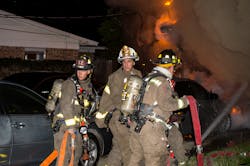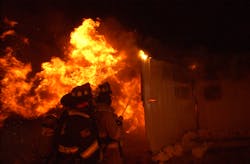The success of command and control is determined greatly by the tactical order of company assignments. This order should be determined by the initial size-up and should be continually updated, because the fireground is very fluid and always evolving. Tactical order also must consider staffing levels and arrival sequence/timing of resources.
All firefighters don’t have the same level of experience, nor are all fire companies created equally. In other words, there are elite fire companies, and there are basic fireground-function companies. So, command might have to consider experience levels and training in the overall tactical success of a specific firefighter or fire company. Chief officers must understand that not every company should be assigned to open a pitched roof or to stand fast in the front yard at a working fire as the rapid-intervention company.
Streams of consciousness
We must understand time-delayed tactics and when it’s appropriate to focus on overall tactical capability that’s based on the number of firefighters who are on scene and the overall number and ability of those who respond to the incident. That said, all fire companies should be able to stretch and operate the first line to accomplish one of the most critical fireground tactics: getting water on the fire. Water is what creates and maintains survivable space that exists when the first fire company that has the capability to apply water arrives. Fire service leaders should ensure that this foundation of engine company operations is the top priority in training today’s firefighters. This training should be solid in the areas of sizing up the stretch. This should entail water application through stream reach from the exterior as well as water application by getting the nozzle inside (to apply the proper amount of water to the seat of the fire). Note: The location for the latter isn’t always the front door. Too many times, I have seen that past frequency of front-door location leads to a default choice over a better one. Yes, the front door frequently is the best option. (Many great fire service leaders taught us that.) However, unfortunately, there have been times when the front door wasn’t the best location to get the nozzle inside of the occupancy, and that catastrophic decision contributed to a line-of-duty death.Regardless of staffing levels, location—and length and size—getting the first line and the second line into operation is the fireground tactic that saves the most lives and provides the greatest return in property conservation. Please, don’t let staffing keep you from making the most of each opportunity to get water on the fire. Training will help get the most success and support the overall mission of fire suppression.
The fire service operates from departments of all sizes, response areas, staffing levels and service delivery capabilities. Nevertheless, all fire departments must rely on the fundamental engine company operation of efficiently and effectively stretching and operating the first line and the second line at fires. They must understand the water delivery rates—fire flows—that are necessary for the potential fires in their territory. They should determine the capability of their tank water and be versed in making the most of fast water off of the first-arriving engine company. (The term fast water has been around for many years, but it might have been a term before its time.) We know that time to flashover can occur in fewer than four minutes from ignition, compared to what was nearly 30 minutes not too long ago.
So, today’s fireground requires rapid water application. How rapid, though, might be determined by the level of staffing and by the amount of training and real-world experience that an engine company has. In rural areas, where response times might be longer and staffing might be reduced, water application might come in the form of one or two firefighters who are utilizing a larger line to apply water from the exterior; interior searches might be delayed. Many rural, and even some suburban, fire departments must use time-delayed tactics based on limited staffing and overall tactical capabilities. In most suburban areas—and, hopefully, in all urban areas—more fully staffed engine companies might arrive closer to that four-minute timeline. That allows them the opportunity to make an aggressive interior attack by stretching a 1¾-inch line that’s flowing 150 gpm to rapidly stop interior fire spread and to control the fire while another company is conducting a primary search.
Regardless of urban or rural, don’t let staffing delay water application. Underwriters Laboratories (UL) confirms that water from the exterior is better than a significant delay or no water application at all. Fight the fire as if it is your house on fire and you don’t have homeowners insurance. The ultimate goal is rapid fire control to save lives and to minimize property loss.Applying water is an every-fire tactic, just as should be rapid primary searches. Sometimes, the search might be delayed by any number of factors, but water application almost never should be delayed. To deliver the highest level of service to the public who we are sworn to protect, our tactical foundation must be solid. Yes, tactics put out fires, but water saves lives. Water doesn’t remove civilians, but it does create and maintain survivable space that allows firefighters the opportunity for more rapid searches and the expeditious removal of trapped occupants. Don’t forget, there are innumerable instances in which civilians who were trapped inside were protected by a closed door, which allowed their survival until the fire department arrived to control the fire. The civilians were able to literally self-rescue once the fire was controlled.
The “Close Your Door” campaign saves lives, but the fire service must back up the campaign with rapid fire control once we arrive. With more residential dwellings going vertical, and with historical data indicating that fires more frequently start on lower floors than higher up, we must rapidly control the fire to allow trapped occupants to evacuate utilizing the stairs (and sometimes the elevator).
UL has worked for years to better understand fireground water application tactics and how they relate to overall operational success and victim survivability. Regardless of whether it’s the exterior attack study, interior attack study or the coordinated fire attack study, each has shown the importance of rapid water delivery and of how water is delivered. The fire service must embrace this large body of research to enhance what we already know through solid experience. Once experience and research come together, we will be better at overall fire control. In the end, this will save more lives, civilian and firefighter alike.
Airing it out
The other major fireground tactic that was part of the most recent coordinated fire attack study is ventilation. With today’s rapid fire growth and volatile fire behavior, coordinated ventilation must be understood now more than ever. (Fires today seem to become oxygen-deprived, or to be vent-limited, more than ever before.) Ventilation can save lives or take lives, and our understanding of ventilation in combination with water application, primary search and vent enter search (VES) is critical. Take the wrong window at the wrong time and it could be catastrophic for interior firefighters who are pushing in on the attack line that has yet to cool the environment or for the search team that might be limited to just a 2½-gallon pressurized water can.The fire service has a proud history of serving the public by saving lives and protecting property through aggressive fire tactics. As much as the fireground has remained the same, it also changed in so many ways (for example, yesterday’s building that has today’s newly purchased furnishings, the makeup and burn characteristics of which are much different than those of old).
We must look beyond the numbers in the UL video on time to flashover. We must examine and understand how this affects our tactics and the timing of those tactics. We must go beyond the CliffsNotes version of fireground operations and delve deeply into all fireground tactics to understand that we might need to tweak our tactical functions based on staffing, response times and experience levels.
Curt Isakson will present “Water on the Fire” at Firehouse Expo. To register, visit firehouseexpo.com.
About the Author

Curt Isakson
Curt “Ike” Isakson is a 30-plus-year veteran of the fire service. He worked for Escambia County, FL, Fire Rescue for 25 years. Isakson previously worked nine years for the Pensacola, FL, Fire Department, where he was assigned as a company officer on Heavy Rescue 31. His fire service experience started at a young age as a junior firefighter with the Midway, FL, Fire District; he rose through the ranks to captain. Isakson's identification of the need for a series of special-interest fire conferences spawned the development of County Fire Tactics, which covers officer development, command officers, water on fire, high-rise operations, and leadership and tactics.



